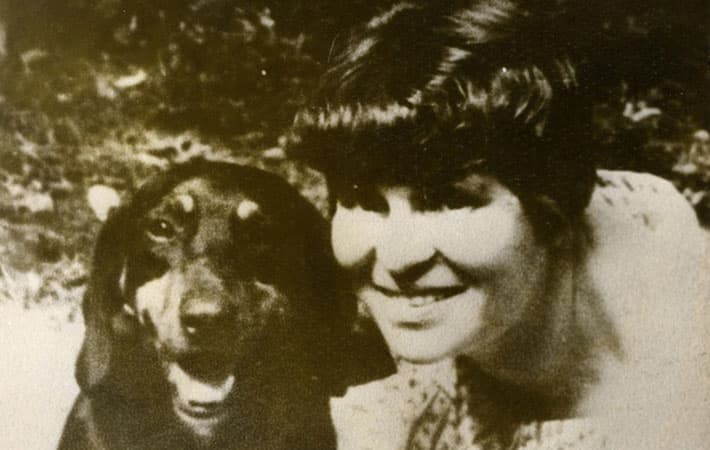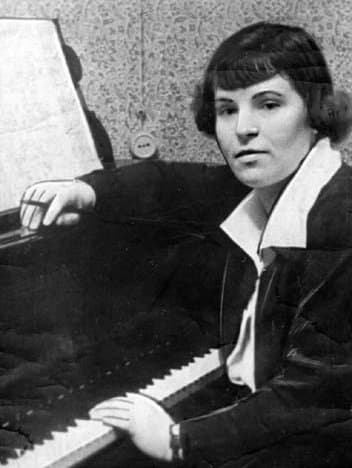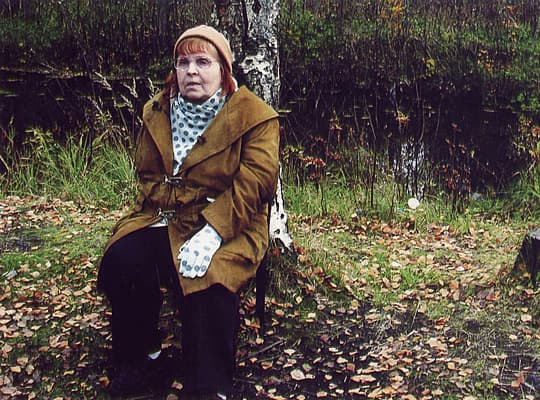It's all about the classical music composers and their works from the last 400 years and much more about music. Hier erfahren Sie alles über die klassischen Komponisten und ihre Meisterwerke der letzten vierhundert Jahre und vieles mehr über Klassische Musik.
Total Pageviews
Friday, March 22, 2024
Orpheum Madams - It Don't Mean A Thing
Berlioz: Hungarian March from La damnation de Faust
Composer Galina Ustvolskaya: The Shostakovich-Trained Iconoclast
By Emily E. Hogstadt, Interlude

Galina Ustvolskaya and her dog
But she was so much more than this. She was also fiercely independent, staggeringly talented, and completely unafraid. She not only refused to fit in a musical mold but threw out that mold entirely.
Today, we’re taking a look at the life and times of Soviet composer Galina Ustvolskaya.
Ustvolskaya’s Childhood
Galina Ustvolskaya was born on 17 June 1919 in Petrograd to an unmusical family. Her father was a lawyer, and her mother was a teacher from impoverished nobility.
Her childhood was lonely and full of financial pressures.
“I would wear an old coat of my father’s (which was too long for me) and his muffler, which I gave to a young friend. I loved to give gifts, although we did not have anything to spare. Since childhood, I could not tolerate these kinds of pressures.”
Her desire for financial security would later impact her career choices.
She loved music deeply from an early age. When she was young, her parents took her to a performance of Tchaikovsky’s opera Eugene Onegin, but the family had to leave when she started crying. “I want to be an orchestra,” she told them.
Time with Shostakovich
Ustvolskaya studied at a school for young people associated with the Leningrad Conservatory. In 1939, when she turned twenty, she joined Dmitri Shostakovich’s composition class. That year, she was the only woman in that class.
Shostakovich was intrigued by her and in awe of her talent. “I am convinced that the music of G. I. Ustvolskaya will achieve world fame and be valued by all who hold truth to be the essential element of music,” he wrote once. He also said, “It is not you who are under my influence, but I who am under yours.”
He valued her opinion so much that he asked for her feedback on his own compositions. He also used a theme from her clarinet trio in his fifth string quartet (from 1952) and his Suite on Verses of Michelangelo Buonarroti (from 1974, toward the very end of his life).
Ustvolskaya studied in his class twice – once from 1939 to 1941 and again from 1947 to 1948. That six-year break coincided with the war, as well as the devastating two-and-a-half-year siege of Leningrad.
A month into the siege of Leningrad, Shostakovich was evacuated to Moscow and Ustvolskaya to Tashkent, the current-day capital of Uzbekistan, along with others linked to the Conservatory. In 1943, she worked in a hospital in the city of Tikhvin, two hundred kilometers from St. Petersburg.

Galina Ustvolskaya
She later made it very clear that she was not keen on an association with Shostakovich. She called his music “dry and lifeless” and wrote to her publisher, “One thing remains as clear as day: a seemingly eminent figure such as Shostakovich, to me, is not eminent at all, on the contrary, he burdened my life and killed my best feelings.”
Her distaste for him may have been rooted in extra-musical reasons. She later claimed that Shostakovich proposed marriage to her, but she turned him down.
Later, she went even further: “There is no link whatsoever between my music and that of any other composer, living or dead,” she once proclaimed.
Ustvolskaya and Soviet Propaganda
From 1947 to 1977, she taught composition at the Leningrad Conservatory. She didn’t think of herself as a particularly talented professor – composition was her true calling – but teaching was a way to make a living.
In February 1948, a resolution went out from the Soviet government, accusing some composers of Formalism (i.e., failing to compose music that fully supported the state).
After this, she split her creative self into two parts. One composed propaganda pieces acceptable to Soviet leadership, while the other wrote secret avant-garde works that she knew might never be heard.
Writing music to please the authorities was soul-destroying, but she was apparently very good at it. Her tone poem Stepan Razin’s Dream opened the Leningrad Philharmonic’s 1949 season, to acclaim. She was even nominated for the Stalin Prize.
However, in 1962, she hit her limit. From that time on, she vowed to only write what she truly wanted to write, and she worked to destroy all traces of everything she ever wrote for political reasons.
Fortunately, later in the century, the Soviet Union started being easier on modernist composers, and allowing them to share some of their more controversial music. Ustvolskaya slowly began sharing some of the music she’d been keeping hidden.
Ustvolskaya’s Later Years

Galina Ustvolskaya
By the 1970s the Leningrad Union of Composers began presenting evenings of her music, and critics were impressed.
Her music has several distinguishing features, including extreme dynamics, unusual instrumentation, and brutal and relentless repetition.
The website Ustvolskaya.org writes, “Ustvolskaya’s music is unique, unlike anything else; it is exceedingly expressive, brave, austere, and full of tragic pathos achieved through the most modest of expressive means.”
Unfortunately, for years, hardly anybody outside the Soviet Union heard it. But in 1989 her work was performed at the Holland Festival, and it made a big impression on audiences.
She was living as a bit of a hermit by the 1990s, but she traveled to Amsterdam to watch performances of her work. Although she hated interviews, she agreed to one with journalist Thea Derk. But when the time for the interview came, she nearly backed out, and only agreed to partake after she was assured she could answer questions with monosyllables, without elaboration. (Luckily, Derk was able to get more than that out of her.)
She was asked how she liked the performance she’d heard. “Not very much,” she said bluntly. She elaborated: “The acoustics were not favourable, so that the piano didn’t come out properly, and the five double basses should have been placed more to the front. Moreover, the ensemble, recruited more or less ad hoc from members of the Concertgebouw orchestra, hadn’t as yet properly mastered the score, and the reciter wasn’t adequately amplified. But yesterday it was better and I hope it will again be better tonight.”
Ustvolskaya’s Death and Legacy
A perfectionist iconoclast to the end, Galina Ustvolskaya died in 2006 in St. Petersburg. She was eighty-seven years old.
In 1998 she gave a description of her life to an interviewer that serves as a kind of thesis statement about her music:
“The works written by me were often hidden for long periods. But then if they did not satisfy me, I destroyed them. I do not have drafts; I compose at the table, without an instrument. Everything is thought out with such care that it only needs to be written down. I’m always in my thoughts. I spend the nights thinking as well, and therefore do not have time to relax. Thoughts gnaw me. My world possesses me completely, and I understand everything in my own way. I hear, I see, and I act differently from others. I just live my lonely life.”